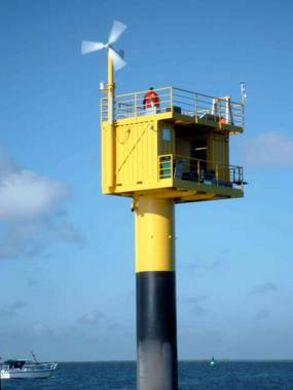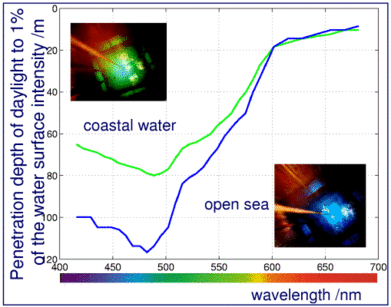Profile
Profile
Profile of the Marine Physics Group
Seventy percent of the earth’s surface are covered by the oceans. This area is much more difficult of access than the land surface. Therefore, its investigation is particularly challenging even nowadays, and at the same time highly attractive. This is also due to the fact that marine research is characterised by interdisciplinary work that includes biological and chemical methods, which is scarcely found in other fields of physics.
Our working group is active in marine research with emphasis on the development and application of optical methods. Water is highly transparent in the visible portion of the spectrum. Dissolved and suspended substances in water lead to absorption and scattering. Another optical effect -fluorescence- occurs when organic matter is irradiated with UV or visible light. These properties can be used for an analysis of pollutants like oil and chemicals, and of naturally occurring substances such as phytoplankton and dissolved organic matter (gelbstoff). Applications of these methods can be found in marine physics, biology, chemistry, and marine surveillance.
Budgets and States of the Wadden Sea
In the frame of the research programme BioGeoChemistry of Tidal Flats, funded by the Deutsche Forschungsgemeinschaft, we elucidate whether the input/output of dissolved and particulate matter between the backbarrier and offshore areas is presently in a steady state or whether the tidal flats suffer a net loss of material. We intend to study the seasonal dynamics of seaward and landward inputs as well as their relation to the retention or mobilisation of specific compounds. Particularly relevant for these processes are extreme weather conditions such as storms and winters with strong ice conditions not allowing to do measurements onbord research vessels.  With the aim to sample data also during extreme weather conditions, the time series station Wattenmeer has been installed in a tidal inlet nearby the island Spiekeroog in the East Frisian Wadden Sea. The station transmits continuous data of physical, chemical and biological parameters of the seawater, and meteorological data via telemetry to the University of Oldenburg. More information is found here.
With the aim to sample data also during extreme weather conditions, the time series station Wattenmeer has been installed in a tidal inlet nearby the island Spiekeroog in the East Frisian Wadden Sea. The station transmits continuous data of physical, chemical and biological parameters of the seawater, and meteorological data via telemetry to the University of Oldenburg. More information is found here.
Laser Remote Sensing
High power lasers emit short intense light pulses which are directed towards the sea surface from board an aircraft typically operating at 300 m altitude. Laser-induced Raman scattering and fluorescence from the upper water layers are collected with a telescope and spectrally analysed. The signals are interpreted in terms of substance concentrations. In this way, phytoplankton, humic substances (gelbstoff) and suspended mineral particles particular are specifically detected with high sensitivity. With the use of very short laser pulses with a duration of about a few nanoseconds and comparably fast light detectors, depth profiles of substances in the upper water column can be derived by converting from the elapsed time to the distance. Because of the analogy to Radar, this method is denoted as Lidar (Light detection and ranging). In clear waters the profiling depth can be up to 50 m, in turbid coastal waters this is limited to about 5 to 20 m depth.  Due to the intense fluorescence of oils, oil pollution on the sea surface can be sensitively detected with Lidar. An instrument that has been developed in our research group is routinely operated by the German Ministry of Transport for airborne maritime pollution surveillance to locate pollutants at sea.
Due to the intense fluorescence of oils, oil pollution on the sea surface can be sensitively detected with Lidar. An instrument that has been developed in our research group is routinely operated by the German Ministry of Transport for airborne maritime pollution surveillance to locate pollutants at sea.
Underwater measurements
Many naturally occurring substances in the ocean can be sensitively detected with optical methods. Dissolved and suspended matter in the coastal zone resulting from river run-off and marine algae are well-known examples. With the use of bio-optical sensors, such measurements can be done continuously as profiles from the sea surface to deep waters, yielding more detailed information in a much shorter time than conventional water sampling and laboratory analyses.  Spectrum of the penetration depth of downward irradiance into the water column to
Spectrum of the penetration depth of downward irradiance into the water column to
1% of the surface intensity at the given wavelength. The upper curve is taken in
the highly productive upwelling area off west Africa, the lower curve in the open
Atlantic Ocean. The optical window of seawater at blue-green wavelengths of about
450 to 500 nm allows for a penetration of light to depths of more than 100 m. In addition to temperature and salinity, sensors for measuring phytoplankton, bacteria, suspended mineral particles and gelbstoff (humic substances) as well as the underwater light field are part of the system. The sensor package is used in oceanographic expeditions jointly with marine biologists and chemists for studying biogeochemical processes. The spectrum of visible and UV-A radiation in the photic zone of the water column is measured with multispectral radiometers. This is of particular interest since most biological and chemical processes in the upper water column are influenced by light and satellite observations are based on optical properties and methods. Relevant processes in the water column are e.g. the photosynthesis of phytoplankton, which leads to a storage of atmospheric carbon dioxide in the ocean, and photochemical decay of dissolved organic matter. The knowledge of optical processes is incorporated into bio-optical models. Such data and models that describe these parameters and interactions provide a better understanding of biological processes, the fate of organic material in the water column, its burial in deep waters, and are thus relevant to the study of climate changes.


